一. inventory 主机清单
Inventory 支持对主机进行分组,每个组内可以定义多个主机,每个主机都可以定义在任何一个或多个主机组内。
1.1 inventory 中的变量含义
| Inventory 变量名 | 含义 |
| ansible_host | ansible连接节点时的IP地址 |
| ansible_port | 连接对方的端口号,ssh连接时默认为22 |
| ansible_user | 连接对方主机时使用的主机名。不指定时,将使用执行ansible或ansible-playbook命令的用户 |
| ansible_password | 连接时的用户的ssh密码,仅在未使用密钥对验证的情况下有效 |
| ansible_ssh_private_key_file | 指定密钥认证ssh连接时的私钥文件 |
| ansible_ssh_common_args | 提供给ssh、sftp、scp命令的额外参数 |
| ansible_become | 允许进行权限提升 |
| ansible_become_method | 指定提升权限的方式,例如可使用sudo/su/runas等方式 |
| ansible_become_user | 提升为哪个用户的权限,默认提升为root |
| ansible_become_password | 提升为指定用户权限时的密码 |
1.2 主机变量使用
写法1:
[webservers]
192.168.44.60 ansible_port=22 ansible_user=root ansible_password=123
192.168.44.40 ansible_port=22 ansible_user=root ansible_password=123
#webservers组中被控制端192.168.44.60的端口号为22登录时用户是root密码为123
写法2:
[webservers]
192.168.44.1[1:2] ansible_port=22 ansible_user=root ansible_password=123
#如果是名称类似的主机,可以使用列表的方式标识各个主机
写法3:
[webservers]
192.168.44.60:22
192.168.44.40:1314
#默认ssh管理时的端口为22,若不是22则直接在被管理ip后加冒号和对应端口号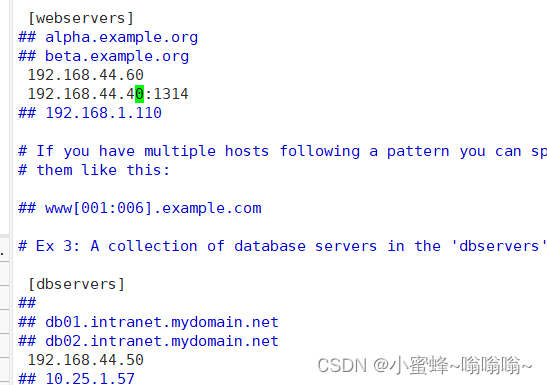


登录测试:


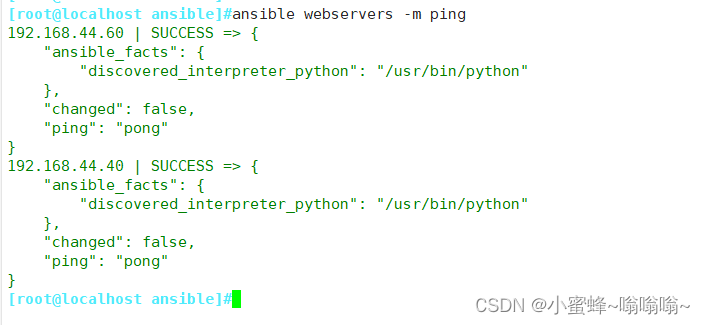
1.3 组变量使用
[webservers:vars]
ansible_user=root
ansible_password=123
#表示webservers 组内所有主机定义变量控制时使用root账户密码为123
ansible_port=1314[all:vars]
ansible_port=22
#表示为所有组的所有主机定义变量使用ssh远程管理时都是22端口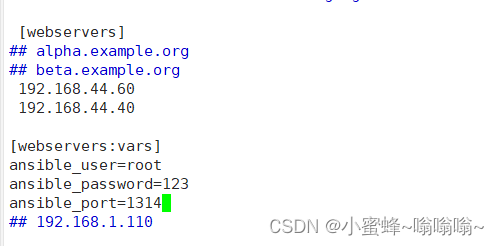
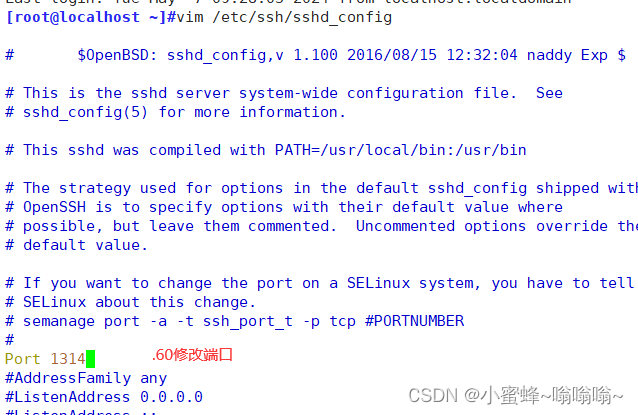

测试:
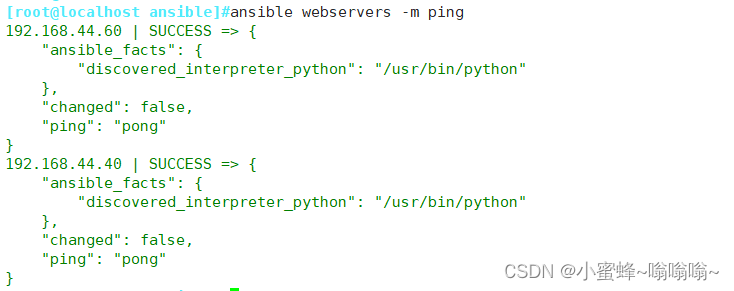
1.4 组嵌套使用
#webservers组
[webservers]
192.168.44.60
192.168.44.40#dbservers组
[dbservers]
192.168.44.50#组内嵌为onlys
[onlys:children]
webservers
dbservers
#表示onlys组的成员即children包括 webservers和dbservers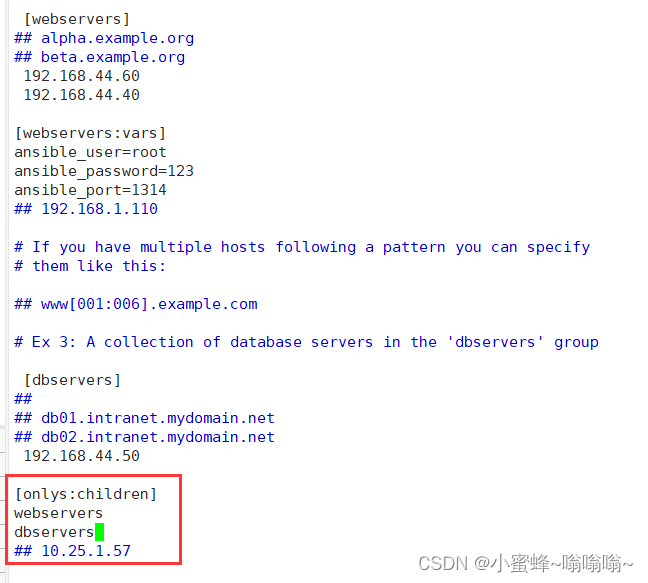
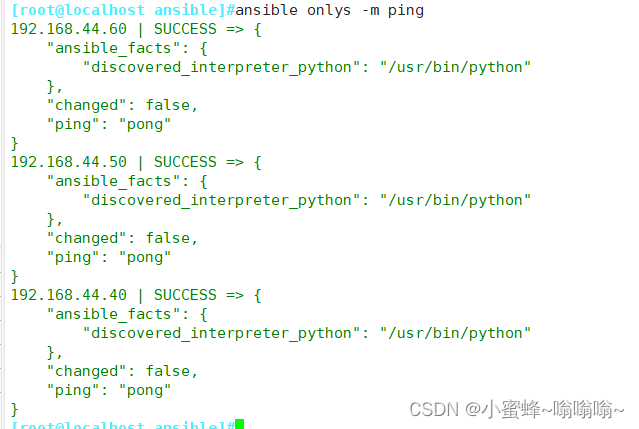
二. playbook 剧本
1. playbook 的相关知识
1.1 playbook 的简介
playbook 是 一个不同于使用 Ansible 命令行执行方式的模式,其功能更强大灵活。简单来说,playbook 是一个非常简单的配置管理和多主机部署系统,不同于任何已经存在的模式,可作为一个适合部署复杂应用程序的基础。Playbook 可以定制配置,可以按照指定的操作步骤有序执行,支持同步和异步方式。我们完成一个任务,例如安装部署一个httpd服务,我们需要多个模块(一个模块也可以称之为 task)提供功能来完成。而 playbook 就是组织多个 task 的容器,他的实质就是一个文件,有着特定的组织格式,它采用的语法格式是 YAML(Yet Another Markup Language)。
1.2 playbook 的各部分组成
- Tasks:任务,即通过 task 调用 ansible 的模板将多个操作组织在一个 playbook 中运行
- Variables:变量
- Templates:模板
- Handlers:处理器,当changed状态条件满足时,(notify)触发执行的操作
- Roles:角色
模板样式:
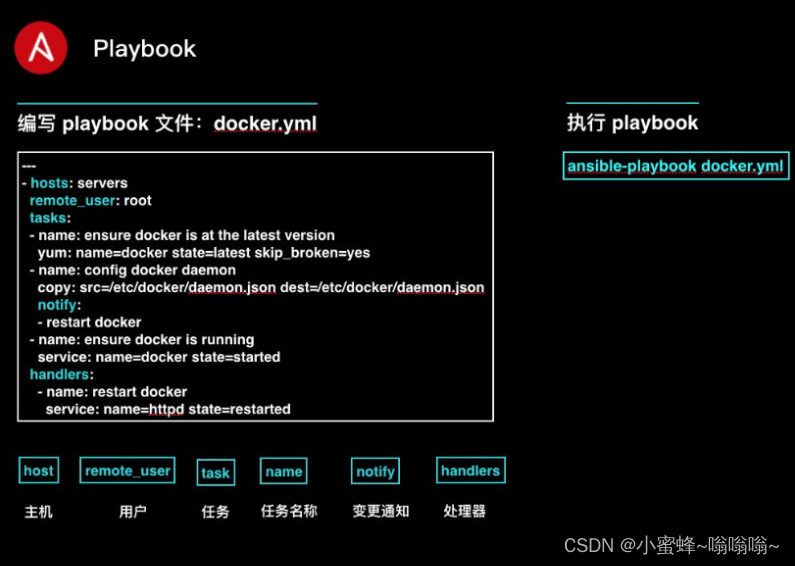
1.3 特点与优势
-
声明式:用户只需描述期望的系统状态,而非具体的操作步骤,Ansible 负责确定如何达到这一状态。
-
幂等性:Playbook 设计为可重复执行,即使在系统已处于预期状态时,再次运行也不会产生副作用。
-
可读性强:YAML 格式和简洁的结构使得Playbook易于编写和维护。
-
模块丰富:Ansible 提供了大量的模块,覆盖了从系统配置到云资源管理的广泛需求。
-
跨平台:支持多种操作系统和环境,适配不同的自动化需求。
2. 基础的playbook剧本编写实例
playbook 中运用的模块就是 ansible 中的模块,就像 docker-compose 一样将 docker 操作容器的指令归纳为一个 yaml 文件,开启运行 yaml 中的指令模块就能按照预设计的方向去完成。
2.1 playbook 编写 apache 的 yum 安装部署剧本
模板格式:
--- #yaml文件以---开头,以表明这是一个yaml文件,可省略
- name: first play #定义一个play的名称,可省略gather_facts: false #设置不进行facts信息收集,这可以加快执行速度,可省略hosts: webservers #指定要执行任务的被管理主机组,如多个主机组用冒号分隔remote_user: root #指定被管理主机上执行任务的用户tasks: #定义任务列表,任务列表中的各任务按次序逐个在hosts中指定的主机上执行- name: test connection #自定义任务名称ping: #使用 module: [options] 格式来定义一个任务- name: disable selinuxcommand: '/sbin/setenforce 0' #command模块和shell模块无需使用key=value格式ignore_errors: True #如执行命令的返回值不为0,就会报错,tasks停止,可使用ignore_errors忽略失败的任务- name: disable firewalldservice: name=firewalld state=stopped #使用 module: options 格式来定义任务,option使用key=value格式- name: install httpdyum: name=httpd state=latest- name: install configuration file for httpdcopy: src=/opt/httpd.conf dest=/etc/httpd/conf/httpd.conf #这里需要一个事先准备好的/opt/httpd.conf文件notify: "restart httpd" #如以上操作后为changed的状态时,会通过notify指定的名称触发对应名称的handlers操作- name: start httpd serviceservice: enabled=true name=httpd state=startedhandlers: #handlers中定义的就是任务,此处handlers中的任务使用的是service模块- name: restart httpd #notify和handlers中任务的名称必须一致service: name=httpd state=restarted
##Ansible在执行完某个任务之后并不会立即去执行对应的handler,而是在当前play中所有普通任务都执行完后再去执行handler,这样的好处是可以多次触发notify,但最后只执行一次对应的handler,从而避免多次重启。剧本编写实现的需求:对 Ansible 管理的所有的 webservers 组的成员,yum 安装最新版本的apache 服务软件,并进行相应环境的调整,确保 webservers 的 apache 服务能够正常运行并设置开机自启
---
- name: install httpdgather_facts: falsehosts: webserversremote_user: roottasks:- name: connection ceshiping:- name: disable firewalldservice: name=firewalld state=stopped- name: install apacheyum: name=httpd state=latest- name: install config filecopy: src=/opt/httpd.conf dest=/etc/httpd/conf/httpd.confnotify: "restart httpd"- name: start httpd serviceservice: enabled=true name=httpd state=startedhandlers:- name: restart httpdservice: name=httpd state=restarted
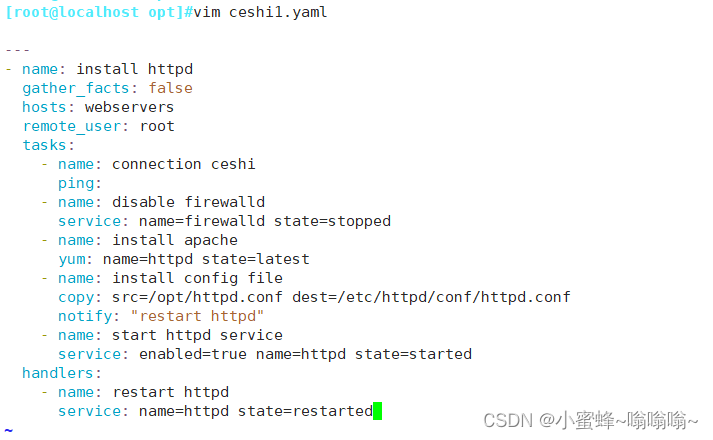
//运行playbook
ansible-playbook ceshi1.yaml//补充参数:
-k(–ask-pass):用来交互输入ssh密码
-K(-ask-become-pass):用来交互输入sudo密码
-u:指定用户
ansible-playbook ceshi1.yaml --syntax-check #检查yaml文件的语法是否正确
ansible-playbook ceshi1.yaml --list-task #检查tasks任务
ansible-playbook ceshi1.yaml --list-hosts #检查生效的主机
ansible-playbook ceshi1.yaml --start-at-task='install httpd' #指定从某个task开始运行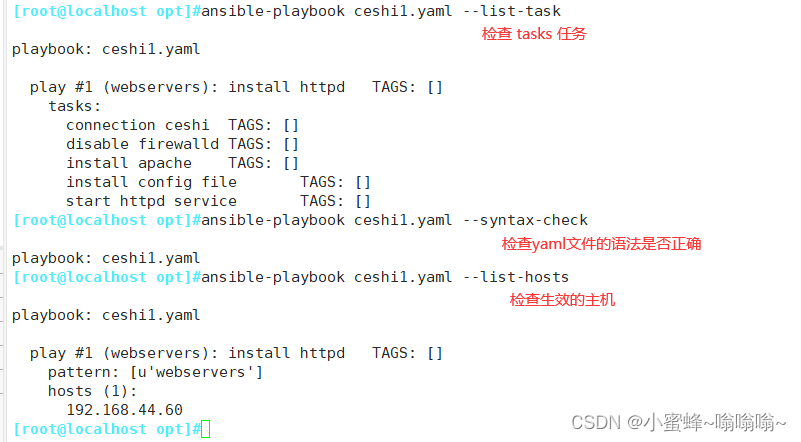

测试看看
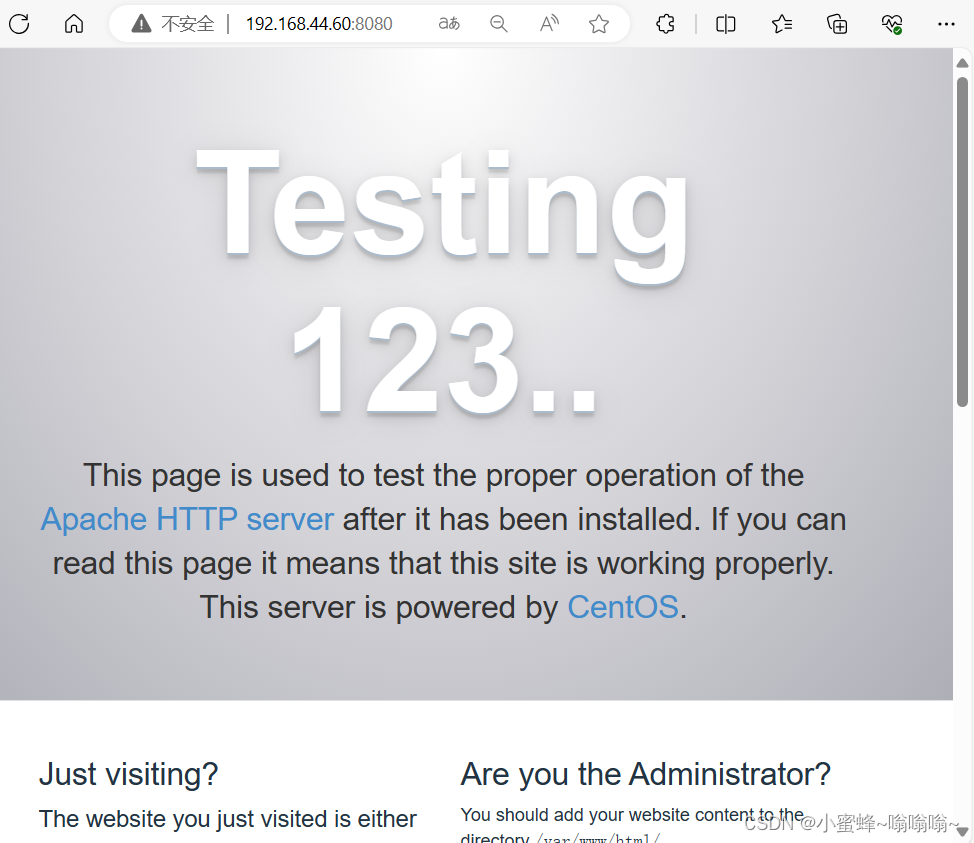
2.2 playbook 编写 nginx 的 yum 安装并且能修改其监听端口的剧本
需求:通过 yum 安装 nginx 服务,并且能够控制被管理的主机的服务的开启,按照预设的配置在运行时的端口。
在编写剧本前,需要准备相应的两个文件,一个为nginx的yum源。一个为相对应的主配置文件,在主配置文件中修改其端口,在将该配置移至被管理主机中,作为运行启动时的默认配置


剧本编写:
mkdir /etc/ansible/nginxvim nginx.yaml
---
- name: nginx scriptgather_facts: falsehosts: webserversremote_user: roottasks:- name: test connectionping:- name: stop firewalldservice: name=firewalld state=stopped enabled=no- name: stop selinuxcommand: '/usr/sbin/setenforce 0'ignore_errors: true- name: prepare nginx repocopy: src=/etc/ansible/nginx/nginx.repo dest=/etc/yum.repos.d/nginx.repo- name: install nginxyum: name=nginx state=latest- name: change portcopy: src=/opt/default.conf dest=/etc/nginx/conf.d/default.confnotify: "restart nginx"- name: start nginxservice: name=nginx state=started enabled=yeshandlers:- name: restart nginxservice: name=nginx state=restarted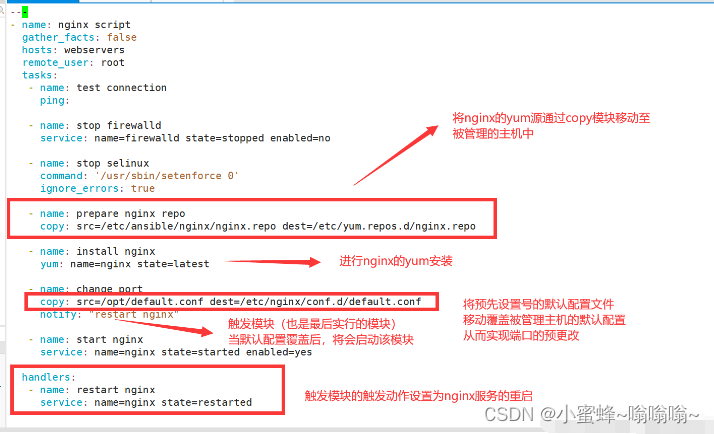
然后运行剧本
再去查看

3. playbook 的定义、引用变量
3.1 基础变量的定义与引用
3.1.1 创建文件
在yaml文件中,我们可以在初始配置的模块中用var去定义变量的存在,变量的格式为 key:value ,以此来确定该变量在剧本中的存在
vim test1.yaml
---
- name: this is a play for testing variableshosts: dbserversremote_user: rootvars:filename: abc.txttasks:- name: touch a test filefile: path=/opt/{{filename}} state=touchansible-playbook test1.yaml


3.1.2 引用 fact 信息中的变量
首先我们知道 使用 ansible 组 -m setup 可以收集该组中所有的节点信息 ,
所以 setup 中 fact 信息,有时候会剧本编写中需要,而 fact 的信息也是可以通过变量的方式进行调用
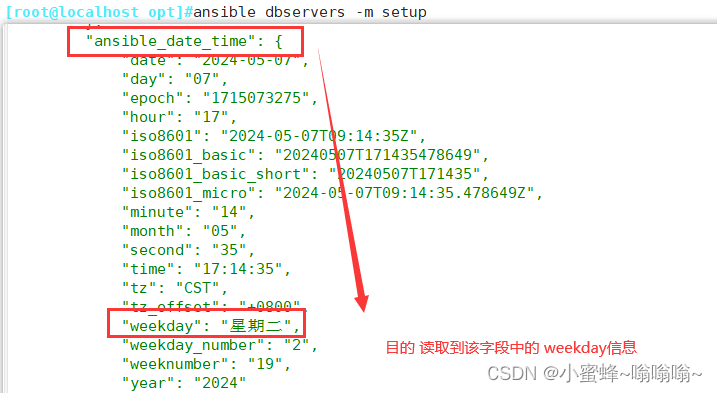
剧本编写:
---
- name: this is a playbook for quote variatehosts: dbserversremote_user: roottasks:- name: reading setup fact variatedebug: msg={{ansible_date_time.weekday}}

3.1.3 综合使用
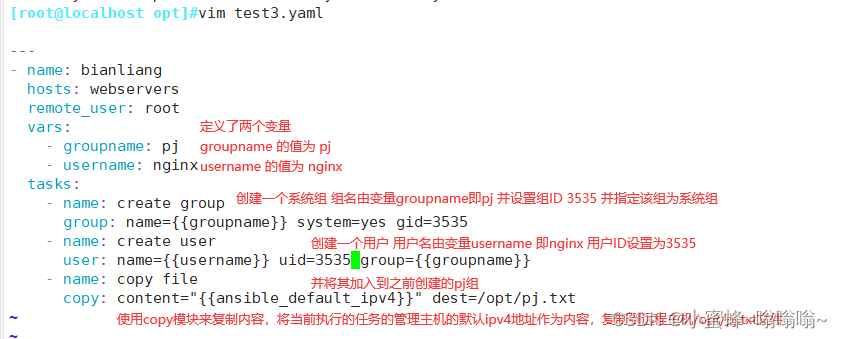

查看:

ansible-playbook test3.yaml -e "username=nginx1"
#在定义行定义变量

3.1.4 指定远程主机sudo切换用户
先在那台机器上创建 zhangsan

报错:


要给zhangsan权限
![]()

联通了

编写剧本
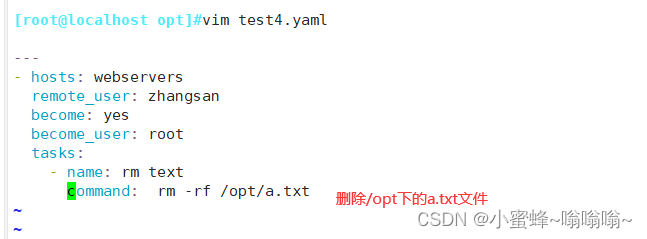
执行剧本

查看测试结果

4. when 条件判断
在 Ansible 中,提供的唯一一个通用的条件判断是 when 指令,当 when 指令的值为 true 时,则该任务执行,否则不执行该任务。
编写剧本
在一组名为dbservers的主机上执行重启操作

执行剧本

成功了 目标主机立即关机重启了

修改剧本,更换地址

执行剧本 由于地址与目标组不一样,跳过了

除此之外 when条件还可以通过 !=(不等于条件来进行判断)


5. 迭代
Ansible 提供了很多种循环结构,一般都命名为 with_items,作用等同于 loop 循环。
编写剧本
---
- name: dd1hosts: webserverstasks:- name: create dirfile: path={{item}} state=directorywith_items:- /opt/x1- /opt/x2- /home/x3
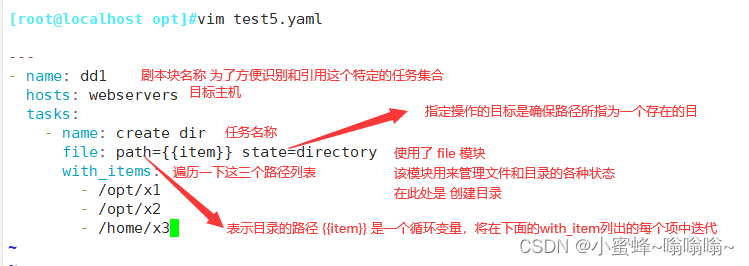
运行剧本
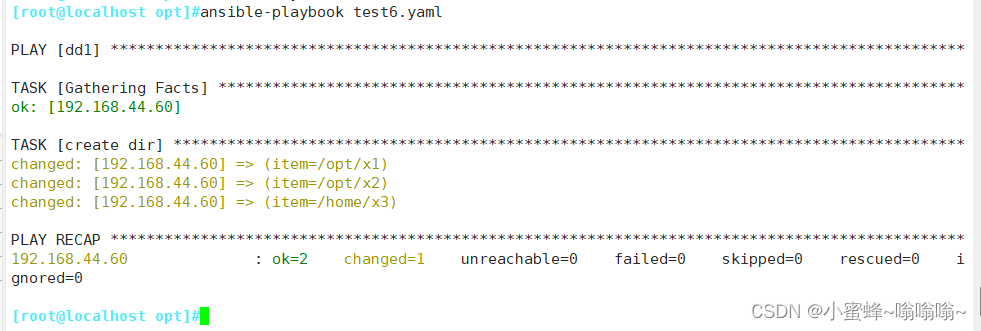
去查看

编写剧本
---
- name: dd2hosts: webserversgather_facts: falsetasks:- name: create dirfile:path: "{{item}}"state: directorywith_items:- /tmp/test1- /tmp/test2- name: add usersuser: name={{item.name}} state=present groups={{item.groups}}with_items:- name: test1groups: wheel- name: test2groups: root

运行剧本
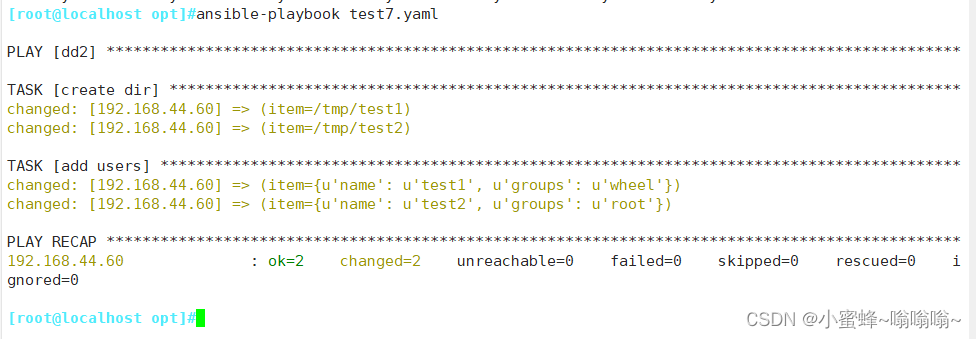
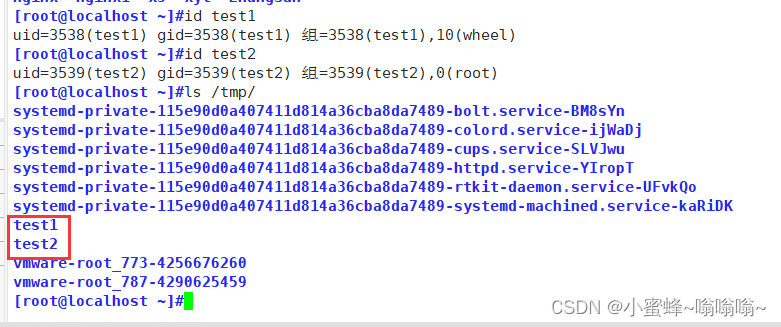











)







